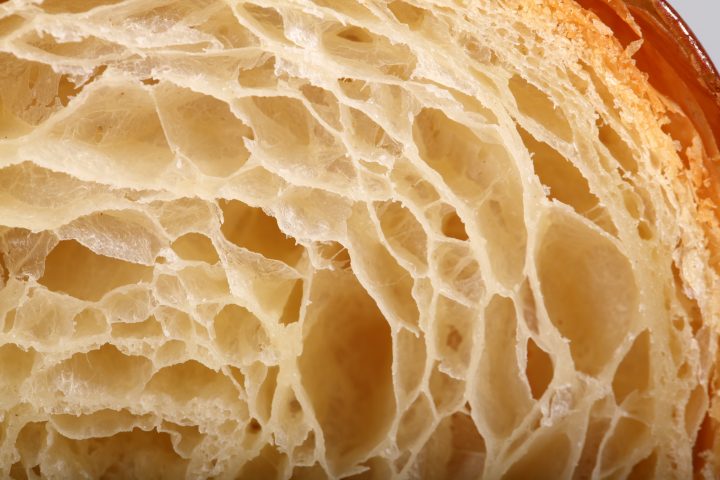
Baking croissants is always a work in progress, hopefully these answers are useful if you are up for the croissant baking challenge…
A lot of (first time) croissant bakers ask pretty much the same questions when tackling this challenging pastry. We composed a list of the top questions with our answers. Pretty sure your question will be answered here. Now lets get to the point of your very valid questions!
GENERAL RECIPE QUESTIONS
Why is your version a three day recipe?
The three day croissant recipe schedule is done for the right planning of the whole process so you can make your croissants on the third day in the morning, but of course you can take less time if this fits your timing better. Take a look at our one day version of this recipe too.
I am a first time croissant baker. What is your best advice?
Choose a cold day with a room temperature below 20 ºC / 68 ºF for your first attempt. This way you will have more time for the whole process and less chance of butter being absorbed by the dough. The key is to keep the butter solid between the layers of dough, this is what gives the croissant its flakiness.
My first attempt croissants look nothing like the ones in your pictures! What did I do wrong?
Do not expect to get perfect croissants the very first time you try to make croissants, most people need to make them 3 to 4 times to get the general feeling for the process. There is no substitute for practice and experience. There is no way to hide little mistakes in your technique when making croissants, so work very precise and follow the instructions to the letter. One small mistake is no problem but several small mistakes add up!
My croissants have a bread-like crumb and no layers. What did I do wrong?
Several factors can be the cause of this. Most likely it is an accumulation of things going sideways. It starts with pressing too hard on the dough to try and lengthen it while it is already fighting back. Keeping at this for a while means, next to the pressing on the dough, you are taking too long and the butter starts to get warm and is absorbed by the dough. So in this case, while still learning and getting better and faster, until you do make sure you build in extra fridge time to cool the dough and then continue. Handle the dough with care, gently elongate without pressing too much or putting your weight into it.
Can I turn your croissant recipe into a sourdough version?
We would recommend finding a recipe that is already a worked out version for sourdough croissants. We are not really a fan of the sour taste in pastry and for that reason we do not have enough experience to guide you to a good enough result.
Can you provide the measurements as ml, tsp, cups, instead of grams for all the ingredients?
We very much recommend weighing your ingredients. Professional bakers use scales (also in the US) and in Europe home bakers do too. A scale will give you the exact same weight every time. Which is absolutely needed if you consistently want to make good bread and especially good pastry. You can get a scale for the same price as a few sacks of good flour and less than a lot of baking tools you already own, so if possible, go and get one!
What are the measurements if I only want to make half of your recipe?
If you halve the recipe, the dough square should be 18.4 x 18.4 cm and the butter slab 12 x 12 cm.
Put the butter slab on top of the dough square and wrap the butter.
Roll the dough into a 20 cm x 30 cm rectangle.
Fold letter style to a 20 cm x 10 cm rectangle.
Turn dough 90 degrees.
Roll from the short 10cm side to a 20cm x 30cm rectangle (the short 10cm side will get 30cm).
Turn dough 90 degrees.
Roll from the short 10cm side to a 20cm x 30cm rectangle (the short 10cm side will get 30cm).
Turn dough 90 degrees.
Roll from the short 10cm side to a 20cm a 55cm rectangle (the short 10cm side will get 55cm).
The size of the final dough, right before cutting, should be 20 x 55 cm.
Although it is possible to use halve the dough we advise to make the full recipe as described in the recipe as the geometry of the shapes are much easier to work with.
You can always use halve and freeze the other halve.
I want to bake croissants, but live in a tropical location. Can I still make them?
We have gotten tips from people who have successfully baked croissants in the tropics. The top tips:
Cool ingredients and even utensils in the fridge before use, and use the fridge a lot to cool your dough and cool for longer if needed.
Roll the dough at night, when it is cooler. Check the weather reports and choose the coolest period possible.
BUTTER
My butter breaks into pieces. What should I do?
We use organic butter with a high fat content and low water content (about 82% fat). A higher water content tends to make butter hard, which promotes tearing and breaking and ruins the layers. Your butter needs to be pliable and at the same time not too soft at the moment of usage.
Help, butter leaks out when baking!
Your croissants were probably under-proofed. Just let them proof a bit longer so they get wobbly and increase visually in size. When under-proofed the butter tends to leak out from in between the layers and you end up with a butter puddle.
There’s so much butter in these croissants! Can I use less?
We would suggest making the recipe with the amount of butter indicated, enjoy the croissants and just try to eat less instead of a less than buttery croissant.
Next day eat soup and a salad.
FLOUR
Can I use another type of flour than the French type 55 you use?
For a good croissant you need the right type of flour. We have tried at least 5 different types and brands before we found a winner. If you cannot get the type 55 French flour try to find a flour with around 11% protein (this can be an all purpose / plain flour) and make sure it is a good quality flour. Try different brands if needed or use a combination of flours. Using 100% bread flour can make your result ‘heavy’ so try a combination with all purpose for instance.
DOUGH
My dough was too moist and sticky to handle. What should I change?
First of all it seems your flour absorbs less moisture than the type 55 flour we are using and you need to make adjustments by using a little less moisture next time.
My dough resists and shrinks back when I try to roll it out. What can I do?
At any stage when the rolling of the dough gets harder you can cover the dough and let the gluten relax for 10 to 20 minutes in the fridge before continuing.
If you keep on pressing the dough, trying to roll it while it resists, you will damage the layers!
SHAPING, PROOFING & YEAST
Can I use fresh yeast instead of instant yeast?
Yes you can. Use three times the amount given (so for our recipe 33 grams of fresh yeast).
Can I use active dry yeast instead of instant yeast?
Yes you can. Use 1.2 times the amount given (so for our recipe 13.2 grams active dry yeast).
At what stage should I add filling to my croissants?
You add filling just before the shaping / rolling up stage. Be aware that any filling will affect the layers and you will need less filling than you probably think. With chocolate for instance you will need no more than 5 to 7 grams per croissant. Professional bakers use stick chocolate for this, but you can use your own good quality (dark) chocolate. Fillings like jams are often added (injected) after baking.
I want to shape my croissants like a crescent. Why are your croissant not crescent shaped?
According to Raymond Calvel croissants laminated with margarine are formed into the crescent shape, while croissants laminated with butter are left in the straight form. We say, use whichever shape you like best, but do use real (organic) butter!
My croissants do not puff up like yours. What should I do?
First check the ‘sell by’ date on your packet of yeast and see if it is still OK to use it. Also make sure the temperature of your dough and proofing environment are correct.
Ideally you should proof the croissants draft-free at a temperature of 24ºC to 26.5ºC / 76ºF to 79ºF
BAKING
Why are my croissants under/over cooked?
Check the true temperature of your oven and see if any adjustments need to be made there. See our tips on the subject: Bread baking tips: Making the most of your oven.
Why are there pools of butter at the bottom of my baking pan when baking the croissants?
This could be a result of under-proofing, so make sure you proof at the right temperature and take the time to proof to perfection and get that nice wobble in your dough. It could also be you were not as meticulous as needed during the lamination process, so stick to the measurements, make sure they are as exact as possible, the edges are straight and follow our laminating instructions carefully.
Help my croissants split open during baking! What did you do wrong?
We suspect your croissants lack real layering and therefor are more bread-like with a lot of butter incorporated. Because they have this substance and are under-proofed and lack layering, you get an oven-spring during baking and the bread splits at its weakest points. With correct layering you get air pockets which will be able to expand and not rupture.
So try to work on your layering by keeping the laminated dough cool, work fast and do not press on the dough when rolling it but gently elongate it.
I want to freeze my croissants and bake at a later stage. What is the best way to do this?
Check out our tips for retarding and freezing with the one day version of our croissant recipe.
You can always find a way to adjust the recipe to fit your schedule.
What do I do to keep baked croissants fresh?
We would advice to put the croissants you do not eat on baking day in the freezer, after they have cooled. For extra flakiness and ‘almost as good as freshly baked’ you can put them into an oven for about 8 minutes at 175°C / 345°F, straight from the freezer.










Krys says
I proof mine for 90 minutes to start. I add more time if I feel they need it in increments of 10. You should see the layers. temp on my proof box is 82 degrees Fahrenheit and the humidity is at 70 degrees Fahrenheit. Assuming your yeast activated properly, temperature could be a factor.
Jasmene says
Why my croissants turned out denser and thick ? What could be the reason? What is the ideal temperature for baking croissants?
Shamsu says
My croissant in side yellow color
CindyL says
Wow. I’m almost afraid to ask a question with all those rules and warnings. Guess I’ll just have to get over that.
About what you said on butter: “We use organic butter with a high fat content and low water content (about 82% fat). “.
I’ve never seen any butter labeled with the amount of fat nor water content in percentages like that. For that matter, I’ve never seen any butter labeled with any info on water. How do we find out this information before buying? I mean, that is, when I’m at the store and looking at all the butter brands, is there something that will tell me what I need to know, while I’m there?
I know this sounds ridiculous, but I am a military wife and shop at what we call the Commissary. There is a “generic” military brand for almost everything but they’re usually made and packaged by bigger trademarked brands, kind of like what Costco does. There are no websites for these generic brands and unless you’re lucky enough to know what trademarked brand was used originally, then there is no website to obtain information.
I’m asking because I will have to make a judgement right then and there. I can probably wing the fat content via the nutrition label but what about the water? I know ingredients are in order of quantity, but I’ve never seen water as an ingredient in butter before.
Phew, sorry it’s so long but I wanted to fully explain.
Samira Cohen says
Hi Cindyl. Yeah…. all those rules and regulations!!! I suppose as a military wife you think you need to follow them to the letter 🙂 Let me tell you, I’ve made croissants with absolutely no idea about what percentage MF my butter had (as you correctly commented, this information is never on the butter package); I’ve made croissants without really measuring the size of my rolled out dough; and I even made croissants with a homemade pizza dough. All were delicious! Use the list of ingredients as a guide and pay more attention to your technique. You can’t go wrong with homemade croissants.
Светлана says
Здравствуйте,хотела бы задать вопрос.Я работаю заготовщиком круасанов уже год.Не выпекаю.В последнее время,почему то появилась такая проблема,круасаны начинают опадать у пекарей в печи.Т.е в расстойке они идеально поднимаются,потом их ставят в печь,они так тоже идеальные какое-то время,а потом резко опадают и становятся плоскими.Никто не может на работе найти в чем причина.А очень обидно,когда из зарплаты у нас вычитают этот брак(((Может быть Вы сможете помочь понять причину?
Hilal says
My croissant cracking sides always what is the problem
Nick Quam says
You may be rolling your croissants while they are too warm and soft. Try chilling them right before forming in order to get a tight and uniform bake.
Kathy Gau says
Why are my croissants not really proofing as much as they should before I bake them?
Eric T Prater says
I wish you had addressed whether or not to cover the croissants during proofing.. I never have, I just put on the 1st coat of egg wash and let them sit uncovered. Is that ok?
Abhishek says
My crossisnant expand to much while baking and get a dirty shape what should I need to do .and i already reduce the yeast quantity in my dough.
Rae says
Proof your dough longer before lamination. If it’s under proved, it hasn’t had a real chance to expand, so when in the oven, it goes crazy. Hanging your yeast will only mess with your bulk fermentation time.
rae says
Changing * not hanging
E McFarlane says
Is it possible to make croissants using dark muscavado sugar instead of white sugar?
marco says
what do you suggest making crossaint around 30 degree celsius room temperature, end product is good but puffs more making it break while cutting.
marco says
during winter crossaint were good but now it’s summer the crossaint are breaking/more puffed,
after laminating when i roll it sticks but after baking it starts to create space/holes between them that’s the main problem here that causes it to break while cutting.
other than that texture are fine.
Indrani Banerji says
What will happen if I add less sugar and increase the amount of salt. To the same recipe with which I was making sweet croissants. Will the same recipe work if I just adjust the sugar and salt , to make it a salty croissant?
Rae says
Do not add more salt. That will retard the yeast and you won’t get a rise. Usually cant be more than 2% salt for any bread recipe. Try adding flaky salt to the top, keep normal salt, and reduce the sugar by a 1/3rd.
ksaieh says
Hi!
I would like to make the croissants bigger. Triangles 38 cm long instead of 25 cms. What should the measurements be for my dough?
Thank you!
Susanne says
Dear bakers!
I would like to make an croissant only with my starter, so how kan i tranfer the recipe to bake lovely croissants? Just by using sourdouch starter in stead of gist?
(11 g instant gist / 32 g verse gist)
great thank you! I love this so much, makes me happy every time i’m baking!
Susanne
Noor says
I forgot to roll my dough after folding in my butter…what should I do now
Caroline Jayasuriya says
What should I do to make less moisture in the dough? My dough became too sticky to work
Ona says
How do I need to bake my croissants so they are nice and fluffy instead of doughy in the center? What would be suggestions?
Thank you,
Ona
Siri says
Butter is speaded while rolling, can we conttinue making them??
Eric T Prater says
Yes you can continue. I’ve had it spread out on me also but they still came out ok.
Rhonda says
Hello,
I got a bag of frozen croissant dough from a hotel surplus sale.
It smells like cheese, but theres no cheese inside.
Is it expired? Also what are indications of spoiled croissant dough?
Tamer says
this is a problem that we are facing here as well. cheese odor in the croissant dough after a few weeks of frozen storage. any clue about the cause. this is a new phenomenon that started a few months back but we cant ID the reason. thanks
Emmie says
Can you describe what is the best consistency for the butter to be to help the first lamination and help prevent the butter from breaking?
Eric T Prater says
The butter and dough need to be the same temperature. They both should be pliable and able to bend without breaking. Temperature is very important.
Claudia says
When my Croissants are in the proofing process (commercial proofing box) not all of them rise to the same size. Some rise much bigger than the others. What am I doing wrong? Could you please help?
Thanks
Deadtruffle19 says
Great post, i always review this page every now and then whenever i encounter problems while making croissant.
I’d like to ask, my croissant always come bready on the center but have a good honeycrumb structure on the outerlayer. What possibly wrong with my croissant? I have thought that layers don’t proofing at the same rate (the center proofing longer) by this giving me another problem, outer layer tend to be overproof. Should i need to ‘warm’ the dough before shaping to get the relatively identical proofing rate on each layers?
Thank you.
Marcelo says
On the proofing before it bakes,how many times the croissant should double or triple in size?
Tks
Ann says
hi,
can advise what temperature to use for the water and full cream milk please?
what do you mean by rotate 90 degrees during day 2 of the laminate the dough process?
Thanks….
Maria says
My dough always tears apart when rolling, although I have do it gently and not pressing too much. After out from fridge the dough is hard to be rolled, I relax it a while outside, then rolls it carefully, then the dough become so soft and some how the dough that is under, tear up no, and the butter comes out. I have given some flour also, but still leak and tear up. I work on 27 degree celcius. What have I done wrong?
Carolyn Speicher says
Much of my butter leaked out during the proofing stage. Where do you normally proof the croissants and what temperature? I put them inside my over with the light on but no heat. That is what my husband does to proof his breads (he’s not up on the laminating tricks though so this might have been too warm).
Aaron says
Try proofing around 79 F for 2 hours. This does the trick usually. You’re looking for the size to double and have a good jiggle.
Eric T Prater says
Yeah, if they jiggle they are ready
Navya says
My croissant was not bready the layers were seperate
Sunny Kularia says
Hello team,
I m using this recipe from long time it’s really good. Thanks for the perfect recipe. Can you please tell me the measurements, if I double the recipe.
Thanks
Andy says
Well, it is double
Carlotta says
It’s my first time baking croissants and so far, the recipe is turning out great. I am at the beginning of day 3 and I am wondering: After I have left my dough in the fridge over night, it poofed up and apparently continued to rise. I have experienced this before when baking bread as my fridge temperature is not low enough to stop the fermentation process. Due to that, I found it difficult to roll out the dough finally and I had to cut off a lot of dough at the edges that was not properly laminated. Also, I am worried that this might lead to overproofing in the end. Should I lower the fridge temperature next time or is this part of the process and recipe?
Sharon says
It seems like my butter would break through the dough when rolling it. Even after folding a few times the butter was very pronounced and would break through the dough. What did I do wrong.
Jose Baez says
Apparently your butter was too cold when performing the lock in process and first lamination. Another thing could be the % of fat in the butter you use. The higher the fat % the better because it will have less liquid inside and it will be easier to roll evenly.
Grace says
Hi. As I was making my layers I found that the butter (which was soft at this point) made the dough soggy and then created tears because of it. When I rolled the dough out there would be ‘wounds’ where the butter would be showing and getting everywhere. Could this have been remedied by sticking it back in the fridge?
The problem arose while doing the folding the second time around (I am using a french recipe that instructs to fold then roll out then fold again).
Jose Baez says
I’d recommend working the dough as cold as possible. In my case i leave my dough in the freezer for some time before lock-in. Also make sure you work in a cool place so you have more time to work properly.
With your dough tearing problem, make sure you develop the gluten properly and enough while mixing the dough. And remember that you need to let the dough rest.
Ilene says
The croissants I received (frozen) were supposed to be cooked from frozen. But they defrosted and have been stored in the refrigerator. I tried baking and they looked great but deflated as soon as they came out of the oven. Are they able to be saved?
Janna says
First time croissant maker here, my dough ended up being too dry before kneading, is there a fix for this? Thanks.
Res says
I’m a beginner for making croissant. After baking My croissant layers has unusual look, the layers appeared too sharp (in my opinion) and very crispy but inside is soft like good croissant I had in general. The layers split out like ribbons put on top each other. I’m not sure if this is something can happen to it and still be acceptable or I should find solution.
My ingredients:
150ml water
150ml milk
14 g dried yeast
600 g plain flour
1 tsp salt
6 tbsp sugar
100g butter
All above to make dough
250g butter for laminating
Baked 10 mins at 200c
Baked 12 mins at 175-180c
I followed instructions for resting in a fridge, one hour after first fold, one hour after second fold, and two hours for proofing after shaped up, covering by cling film in warm place as possible but not too hot.
Please you advise if I did it right or what and which process I did wrong. Thank you.
Darlene says
I am a very big goner croissant baker but from my local French bakery the outer layers do get crispy and flakey. When I do their “bake from frozen” croissant dough (pure French croissant dough not cheap manufactured dough) the outer layers are distinct and can be thin and crispy at the edges after rising overnight and then baking. Sounds like you have perfect croissants. Mine, on my first try, turned out like bad canned dough crescent rolls! I need lots more practice.
Darlene says
Sorry meant very beginner.